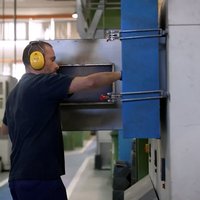Viruses, pay attention!
Like many others, this young man from Usurbil has passed the infection caused by the H1N1 virus.
FROM PAKO AGUDO
"They called me and told me to get out of work immediately, that I'd probably be told and... with all the fuss that was going on. I came to the doctor and my lungs were very bad. I started with a strong cough, a little fever and then they took me to the hospital. It's a little different. I don't know better or worse, but different. In the others I had a higher fever and perhaps this time less fever -around 38.5 - but yes, a lung unit with a much higher load."
It's been months since Pako Agudo got sick. Since then, thousands of people around the world have been affected by pandemic influenza.
The microbiology laboratory of Hospital Donostia is the reference laboratory for influenza in the Basque Autonomous Community. The first screening for influenza A was conducted on April 26. A sample of a Bilbao patient returning from Mexico was analyzed. Since then, tests to detect the new flu have been carried out daily. Up to 15 September, 2,000 samples were collected and 400 tests were positive.
Viruses are intracellular parasites. They do not have the opportunity to live freely in the environment. They need some cell to enter, live and reproduce inside.
To determine if a patient's sample is infected, viruses are grown in cell lines. The cell cultures are a variety of horticultural analogs. Just as soil is required for the growth of vegetables, cells are required for the growth of viruses. Patient samples are cultured in cells. If there is a virus-infected sample, the cell cultures will also be infected.
DIEGO VICENTE; Hospital of San Sebastián"We use
different cell lines. Every virus needs an environment to grow. Not everyone likes the same cells and a lot of different cells are used: human cells that grow very quickly, tumor cells; or canine cells, or monkey cells... For the growth of the influenza virus, canine kidney cells are used. Many cell types are used. We choose the cell line according to the needs, according to the virus we want to look for."
Millions of cells are grown in bottles and then dispensed into smaller vials. Each vial contains approximately 125,000 to 150,000 cells. The viruses are grown in these vials.
DIEGO VICENTE; San Sebastian Hospital.
"We have 24 to 72 hours of incubation of the vials at the appropriate temperature, between 35 and 37 degrees. Every time, we put the vials under a microscope and look at the cells to see if the viruses appear and the cells are getting sick. if after 72 hours we see that they have become ill, we attach the viruses to the specific monoclonal antibodies. Antigorputz horiek gai fluoreszente zehatzekin markatzen dira eta birusa dagoen ala ez begiratzen dugu fluoreszentzia-mikroskopioan".
Molecular biology techniques are also used to detect viruses in patient samples. The times have been considerably shortened thanks to these techniques, which currently obtain the result of the analyses in up to one hour.
Virus detection analyses are performed on 10,000 samples each year at San Sebastian Hospital. Most of the viruses that appear in the tests were discovered a long time ago. But some are not that well known. since 2000, several new viruses have been recognized thanks to new molecular biology techniques.
GUSTAVO CILLA, San Sebastian Hospital
"Humans have been affected by these viruses for centuries. But until now they have not been found because they do not grow in cell cultures. It has been necessary to wait for the appearance of new molecular biology techniques to find them."
The San Sebastian Hospital has spent years researching respiratory viruses. One of these studies found a new means of transmission of another virus.
GUSTAVO CILLA; San Sebastian Hospital "Human
bocavirus is contaminated by the respiratory tract. But it has also been discovered that it can be contaminated by the gastroenteric route thanks to studies carried out. It also causes gastroenteritis. It is important to know this, because knowing the means of transmission of viruses is essential for taking preventive measures.
At the boundary between living and non-living, viruses need cells to reproduce. In plants and animals, they find cells suitable for proliferation. The reproductive mechanisms of the cell incline them to their needs. As a result, the cell is destroyed after the formation of hundreds of new viruses.
Viruses infect humans every day. Infections are usually mild. They may cause a little fever and/or a mild headache. But a small percentage of infections can be serious, very serious, or even fatal.
GUSTAVO CILLA; San Sebastian Hospital
"The viruses have caused diseases that have had an enormous impact on human health. They are caused by viruses such as AIDS, influenza pandemics, poliomyelitis, measles, smallpox... On the other hand, some viruses are highly contagious and can cause epidemics that can affect thousands or millions of people and are difficult to control. On the other hand, there is another factor to consider. Viruses are very simple creatures, so it's hard to attack them."
Hospitals all over the world are alert to the possible appearance of new viruses. In fact, viruses change easily. This is one of their characteristics and they can even cross the boundary between species, as the H1N1 virus of the new flu has done.
GUSTAVO CILLA; San Sebastian Hospital
"These are natural phenomena. It has always happened and it will probably happen again. You might think that the chances of it happening will increase because we are more and more people on the planet, growing more and more animals and birds to feed us, and we have even reached the end of the planet. All of this could lead to animal viruses jumping into humans."
The Aritz Boy has just been in London and noticed the first symptoms of the flu in England.
I started
to feel it and didn’t know what it was. Start to raise the fever in the food, go up, go up... Give me Tamiflu zostan and tell me I couldn't travel as long as I had a zostan fever. I had heard a lot about the flu in Dela, coming here, I said we were going to the hospital and we went to the hospital in Mendaro.
Mobility is one of the hallmarks of globalization. Nearly 3 billion passengers took a flight in 2008, according to data from the International Civil Aviation Organization. The transit of goods by land, sea and air is even greater.
This high mobility contributes to the rapid spread of viruses. in 2003, a patient suspected of having SARS was admitted to the hospital in Basurto. SARS is a very aggressive coronavirus. The Basurto hospital is one of the reference laboratories in the European Union for the analysis of this type of special pathogens with quality control.
RAMON CISTERNA; Hospital of Basurto"Special
pathogens are those that have a certain virulence of one kind or another. They have the ability to inflict unconventional pain."
They are not usually diagnosed. Hospitals aren't used to working with them. For this reason, some laboratories are specifically prepared.
RAMON CISTERNA; Hospital of Basurto"Smallpox,
lupus, tularemia, can be a plague, that is, something very aggressive, something that generates a lot of pain. It is really very difficult for all hospitals to be prepared to be diagnosed. That is why a small number of laboratories, one for each Member State, have been selected to be able to diagnose pathogens of this type at any given time."
Samples are sent to Basurto from the reference center in Germany. We want to know if they are really able to diagnose everything that is being sent to them.
RAMON CISTERNA; Hospital of Basurto"Let
no one be alarmed, let him not think that they send us this type of pathogens. They send us nucleic acids, they have a trace of genomic nature there, and we need to identify that."
Experts warn that others will also emerge after the new flu virus. Being able to detect them as quickly as possible is a way to stop the spread and create new vaccines . In fact, the therapeutic efficacy of drugs is currently limited.
RAMON CISTERNA; Hospital of Basurto"This
is the main challenge of medicine at the moment: to obtain substances that are able to effectively treat viruses without harming the cells that undergo proliferation."
Buletina
Bidali zure helbide elektronikoa eta jaso asteroko buletina zure sarrera-ontzian










